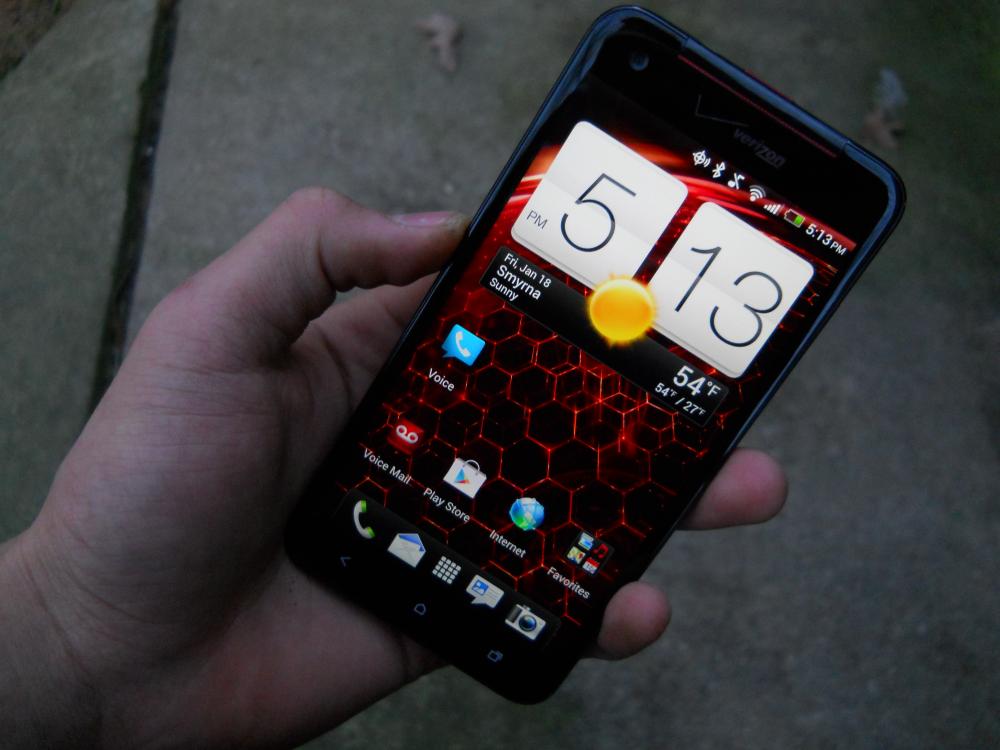Review: HTC Droid DNA
It may seem odd to begin a review of an HTC smartphone with the mention of a Samsung device. And yet, that is exactly what I’m going to do. While a bit strange, it actually makes at least a little sense to mention the Galaxy Note II before talking about the Droid DNA, especially since I just reviewed it a few weeks ago. The Samsung Galaxy Note II is supposed to be the premier smartphone in the 5-inch range that borders on small tablet size, but I actually didn’t find the Note too inspiring, and the Droid DNA seems to be a worthy alternative. While slightly more modest in the display department, the 5-inch HTC Droid DNA is nevertheless a competitor in the larger smartphone class, and it has some impressive specifications to back up its claim. Of course, the 1080p display and Snapdragon S4 can only get it so far if the software isn’t up to par or the battery life is atrocious, and the DNA can’t become the best with specifications alone.
So, can Verizon’s exclusive HTC powerhouse come out ahead of Samsung’s international hit that created its own category? Read on to find out if, or how, the Droid DNA stacks up to the Galaxy Note II and the rest of the competition.
Quick Specs
If there’s one area where the Droid DNA clearly stands out, it is the specification list. Behind the 5-inch 1080 x 1920 Super LCD display, the DNA packs a quad-core Snapdragon S4 Pro, 2GB of RAM, and 16GB of storage. An 8MP rear camera sensor supports 1080p HD video, while the 2.1MP front camera supports higher resolutions than other front cameras. Powering the show is a 2020mAh battery, which uses the device’s large surface area to remain deceptively thin. The DNA also packs quite a number of connectivity options, including Bluetooth 4.0, WiFi a/b/g/n, NFC, Verizon LTE, and the standard 3.5mm headset jack and microUSB charging port. Not so standard is the inclusion of wireless charging based on the Qi standard, but like the Nexus 4 there isn’t yet an official wireless charging pad yet.
Packaging
The more smartphones I unbox and eventually review, the more I get tired of the packaging. Once again, the packaging on the DNA is standard fare, with a box that opens from the top to reveal the smartphone, with the accessories crammed in under it. You can see the full set of accessories in my unboxing post, but there aren’t any surprises to be found.
Hardware
On the front, the Droid DNA is a standard glass slab of a smartphone, with a few interesting accents to keep things from getting too boring. The large glass surface is smooth around the edges, which has a very nice effect when swiping from side to side. Overall, the design is very simple and classy (perhaps with the exception of the Verizon logo at the top), but still manages to be unique and clearly an HTC design. 
At the top of the display is the speaker grille, which is tinted red and offset ever so slightly from the rest of the device from a top bar. To the left is the front camera, and directly in the center you can see the Verizon logo. The image above can speak for most of the design, but I particularly like the way the slight red accents the otherwise black device, and how the speaker looks like it is part of, although offset from, the top bezel. 
The bottom of the display contains capacitive, physical navigation buttons that Google has been trying hard to get rid of. While it technically goes against the design principles of Android, I don’t mind these buttons at all because they match up with the virtual buttons that would otherwise be offered, even down to the order in which they’re placed. Additionally, HTC has followed Google’s instructions to ditch the menu button, and include a proper multitasking button instead.
Turning to the bottom of the device, we find the standard microUSB port hidden under a flap that is pried up and hangs awkwardly off of the device when not in use. Unlike the sliding door on the Galaxy S, while in theory a good idea, the dust cover really just gets in the way when trying to plug the DNA in, and I can see it easily snapping off after a few weeks of normal use. It may look good when closed, but it doesn’t make a big enough difference to negate the minor hassle that it cause. 
At the top of the smartphone, directly in the center, is a bright red power button. This wouldn’t be too much of a problem, except for the fact that the phone is quite tall. This alone makes me wish for a side mounted power button, not unlike that of the Note II and other Samsung devices. Still, the red accent looks nice, and the tactile feel of the button is good. To the left of the button, we have the standard 3.5mm headphone jack, which works as one would expect. I explained my preference for bottom headphone jacks in my Note II review, but except for certain specific situations, the top mounted headphone jack is perfectly fine. To the right of the button is the microSIM card tray, which requires a tiny pin to open. (One was supposed to be included in the packaging of my DNA, but wasn’t for me, for one reason or another. )
The left side of the device is dominated by what looks like a huge speaker grille, but is in fact just a decorative metal grate. It looks good and makes the two sides symmetrical but doesn’t perform any other function. I imagine that the sound would be quite good if both sides were dominated by actual speakers, but that sadly isn’t the case here. 
On the right side of the device, nearly at the top, is the volume rocker. The red buttons are blended into an identical grille to the one on the left side, but don’t have the same texture. If anything, the buttons don’t stick up quite enough, but the tactical feel is otherwise decent, although it could perhaps have a bit more travel.
The back of the DNA is a matte black soft touch coating that is tapered around the edges, which feels great, provides grip, and makes the device feel thinner than it is. Centered at the top is the camera and flash, lower on the device is a simple HTC logo, and at the bottom things get a bit busy with Verizon 4G LTE, Beats Audio, and FCC logos, as well as the loudspeaker.
As a whole, I much prefer the physical design of the Droid DNA to that of the Note II. It does have a slightly awkward tall factor, but isn’t nearly as wide as the Note II. This makes it much easier to hold in one hand, even if you can’t reach all the buttons. The back cover may not be removable, but in exchange it feels extremely well built, with a great “grippy” texture. The tapered sides also help keep the device from feeling too bulky, and help it fit into your hand quite easily.
Interestingly, when looking at the Droid DNA and my Nexus 4 side by side, the DNA actually isn’t a much bigger device. They are both about the same thickness and width, and the DNA is only about 3/4 of an inch taller than the Nexus 4. This results in a very similar in-hand feel, which, although it can occasionally get a bit top heavy, is usually very similar to a smaller phone. Your thumb won’t be able to reach the far corner of the screen with one handed use, but otherwise the DNA doesn’t actually feel too different from a more standard smartphone. This simple change, along with the fact that the DNA feels more well built and more like a quality device than the Note II, are what convinced me to give it the edge in build quality and design. Those who need a removable back cover will have to look elsewhere, but otherwise the Droid DNA provides an extremely solid and good looking smartphone that, overall, isn’t too awkward to hold, despite the larger display.
Display
There is no doubt that the display found on the Droid DNA is one of the most technically impressive available today. While it may not have the physical size of the Note II, it has the claim to fame of being one of the first devices to ship with a 1080p display. This 1080 x 1920 panel has an impressive pixel density of 441ppi, which is huge even without taking into account the screen size. When I reviewed the HTC One X, I raved quite a bit about how good the display was, mostly in part to the Super LCD technology. Between the Super LCD 3 technology and huge 1080p resolution, the display on the Droid DNA is even better than its predecessors. As with the One X, the display is so good that the image almost appears to be floating over the device. Combined with the pixel density, this creates a nearly magazine like quality for the display, which looks absolutely great. As with any display that isn’t of the AMOLED variety, black levels suffered ever so slightly compared to the true blacks on most Samsung devices. However, more and more devices are using good LCD panels instead of AMOLED (the Nexus 4 is a good example of a recent switch), and with good reason. The LCD panel on the DNA is brighter than an AMOLED display, arguably has truer colors, and overall looks incredible. I would pick it over the Note II or Galaxy S III.
Software
The Droid DNA is running Android 4.1.1, with HTC Sense 4. While the Android version is a bit higher than that on the One X, the Sense 4 skin means that the Droid DNA is very similar in software terms to the One X. In fact, the interface is nearly identical, and apart from Verizon’s customizations (such as the Amazon widget above and a few changes that came along with Android 4.1 Jelly Bean), the DNA’s software is the same as the One X’s.
If we don’t include Verizon’s applications in the picture, then the Droid DNA doesn’t really come with too much extra bloatware. The only two apps that I installed before the above screenshots were Voice and Flashlight, so the remaining non stock apps were the work of either Verizon or HTC. HTC includes its own Tasks and Weather apps, as well as customizations to many stock apps, while Verizon includes quite a few of its own essentially worthless apps, including the Zappos advertisement that I complained about in the Note II review.
The browser found on the DNA is once again the same as the one found on the One X, and it still works just as well. Pinch to zoom and navigation work as expected, and the tab switching view mirrors the multitasking view and operates smoothly. I’m partial to Chrome, however, and so far I haven’t found a manufacturer customized browser that is good enough to change that sentiment.
With Android 4.1.1 Jelly Bean, a feature that the DNA does have which the One X does not is Google Now. Interestingly, it is accessed by holding the home button, which is similar to the swipe up used by stock Android, but also easily confused with the old shortcut for the multitasking menu. However, the DNA has a dedicated multitasking capacitive key, which opens the interface you see above. Oddly, apps can’t be swiped up or down to close them, and there isn’t even a shortcut to the task manager. The only thing that the recent apps dialogue does is switch apps, but that it does quite well.
One thing that I do find a little bit odd about HTC Sense is the way the launcher manages customization. There is no menu button to bring up a wallpaper menu, and widgets are not included in the app drawer. Instead, you must guess and long press the homescreen to pull up the add widget dialogue, and the Personalization menu that controls the wallpaper is buried in the settings. Everything you would expect to find is there, including different skins for different scenarios, but it just isn’t very easy to find these customization options.
The notification bar in Sense is odd in that it is very plain. There are no quick toggles, no contextual suggestions, and no brightness control – only notifications, and a shortcut to the settings menu. While I do like to have a few simple toggles, on the whole this is a nice change from the Note II’s overly cluttered notification shade. The settings menu in Sense is perfectly fine, although it seems to look a little bit like older versions of Android, despite the toggles and categories. I also don’t like the animation for overscroll, which you see above. To me, it just looks awkward.
The phone and messaging apps on the DNA are, apart from some very slight cosmetic differences, identical to those found on the One X. The dialer works well, and the messaging app looks decent as well, but I’m not a huge fan of HTC’s keyboard. The keys seem just a little too close, resulting in unintended presses. The prediction is also not great, and no Swype feature is included out of the box. The keyboard works decently, but doesn’t do anything so well as to make it good.
While the app drawer doesn’t have a separate section for HTC apps, it does have a tab for Verizon’s inclusions. Although most people probably won’t be interested in this particular tab, it is nice that HTC allows you to add and customize the tabs, and further organize the app drawer beyond what is usually possible.
The gallery is another Sense app that hasn’t changed since the One X, and still uses the same simple view. It works fine, and includes share options, but not any photo editing that I could find. The Music app in sense is a bit redundant since Google Play Music is also included by default, but the Sense app also includes TuneIn Radio, Amazon MP3, and Slacker radio features. Although I never had to use the app, I do like TuneIn and Amazon MP3, and don’t doubt that the features will be useful to some users. However, since I mostly live in Google’s cloud, Google Play Music is pretty much the only Android music app that works for me.
HTC also includes its own task app that syncs with Google tasks, and is actually quite good. It can sort tasks by lists or by due date, and it has a simple yet functional interface. For once, this is an app from a custom UI skin that I would like to see available for all Android devices. Currently, I’m trying to decide between Gtasks and Tasks for to-do list management, but if I had a stock HTC device for my daily driver, I would more than likely just use HTC’s offering.
Interestingly, HTC’s battery use dialogue is a bit different from the usual fare. It allows you to kill apps and see which ones are using the most resources, which is something that takes an extra tap in stock Android. However, I included this screenshot because, however good Sense might be, it is still clearly something of a resource hog. Using 51% of the battery, twice as much as anything else, probably isn’t a good thing, and illustrates why I don’t particularly like third party skins even if they work well.
The Droid DNA comes with 16GB of storage, but as with any device, much of the memory is used up by the OS and stock applications. Users only have a little more than 11GB to play with from the beginning, which can quickly fill up. Since the Droid DNA doesn’t have an SD card slot, this could potentially become a problem.
While the Android version could be higher, and Sense hasn’t changed much from the previous version, I still think that Sense works fairly well and is on the whole a better custom UI than TouchWiz. Whereas I don’t like TouchWiz for being too cartoonish, Sense is to me quite a bit more professional and simple looking. The UI does have odd touches, like the music app and settings menu icons, but as a whole Sense is more polished than TouchWiz, and generally works quite well. That isn’t to say that it is better than stock Android, which I still prefer to any skin. However, as a whole Sense has a decently fast and fully featured launcher, doesn’t make too many customizations to the stock apps, and errs on the side of less when it comes to notification bar, multitasking menu, and settings area changes.
Basically, HTC Sense is decent, almost nearing the side of good. It has its quirks, but the functionality and design of the UI manage to make it neither a pro or con. Don’t get me wrong here, if HTC had tried to make the DNA into more of a phone/tablet with a display any larger than 5 inches, or even a wider aspect ratio, then Sense would not have been nearly as good. Like TouchWiz on the Note II, Sense with Android 4.1 is still clearly a smartphone OS, which doesn’t reap too many of the benefits of the larger screen other than longer menus and better videos. However, unlike on the Note II, the software doesn’t have to make up for as many compromises. It doesn’t have to make the DNA useful as a tablet phone, because the DNA still leans more to the side of the smartphone rather than the small tablet. For that use case too, I’ve always preferred Sense to TouchWiz, and that is still the case here. Stock Android would be even better, but Sense feels closer to something that I would use than Samsung’s, LG’s, or Motorola’s custom software.
Performance
As you will see confirmed in the section below, the Droid DNA is simply a powerhouse. The quad-core Snapdragon S4 can power through any difficult task with ease, and no number of applications will use up all the 2GB of RAM. Even pushing such a high density display, the hardware of the DNA acts as if running graphics intensive games is no problem, and the homescreen transitions are always silky smooth even with the extra effects and bloat added by HTC Sense.
There is almost never a moment where the DNA lags, and when there is one it is because of software, not hardware. Occasionally, you will have to wait momentarily for the dialer interface to load or the homescreens to redraw, but I am certain that these delays are the fault of bad management by HTC Sense. Even so, these tiny annoyances are few and far apart, and don’t impact the experience at all. Along with the display, the Droid DNA has some serious hardware specifications to back up its top-tier position, and unlike the Dallas Cowboys, the stats on paper really do translate to real world performance. I would go as far as to say that the Droid DNA feels like the fastest phone I have tested, and that I prefer the Snapdragon S4 Pro to Samsung’s Exynos.
Benchmarks
In case you need data to back up that previous claim, here it is. In the Note II review I linked before, you can find the Note’s scores on the same tests, which were all lower than the DNA’s.
Quadrant
Vellamo
Linpack single and multi thread
AnTuTu
Connectivity & Phone Calls
Just like most of the Verizon smartphones that I have tested so far, the Droid DNA performs admirably on LTE. The speeds you see above are just about average, and are fairly consistent here in Atlanta. I haven’t found many places other than the mountains where Verizon’s coverage isn’t superb, so I can almost always be certain that Verizon’s speedy LTE network is at my fingertips.
Interestingly, the Droid DNA includes two connectivity options not often found in smartphones. NFC is gaining popularity with manufacturers like Samsung, but it still isn’t a given in every phone. I wasn’t able to use Android Beam even though the DNA should theoretically include it, nor was I able to test wireless charging, as I haven’t gotten a wireless charging pad for my Nexus 4. Still, I like having both NFC and wireless charging available, and think that eventually both will become indispensable features for any smartphone.
Call quality on the Droid DNA is above average as well, and I never dropped or missed any calls. Most callers sounded great through the DNA’s speaker, which suggests the other carrier was at fault for those who didn’t. The DNA’s noise cancelling microphone also works quite well, making sure that the sound quality out of the device is as good as the sound coming in.
Camera
I always say when reviewing smartphone cameras that I don’t really think that a smartphone will replace most people’s dedicated cameras anytime soon, but with each new smartphone, I find better and better image quality, faster shutter speeds, and generally better performance. The Droid DNA is no exception, in that it has improved camera performance over the already impressive One X.
It focuses quickly, the shutter is nearly instant, and even close up images turn out quite well. I wasn’t quite clear on how to navigate HTC’s camera software, but overall the camera on the DNA does a great job in bright light with both landscapes and close up. It also does decently in lower light situations, but suffers some quality as any smartphone camera. As a whole, the camera on the Droid DNA is still above average, as I found it easier to take shots that looked great than with the Note II. Whether that is because the focus and the shutter are faster or the camera is actually of higher quality I don’t know, but I do know that it is actually fairly easy to produce very good looking images with the Droid DNA’s camera.
Battery Life
I generally dislike talking about battery life when I review smartphones, simply because there really isn’t a good objective test that simulates real world use. Video battery drain tests may give you an idea, but really there are so many different use cases, configurations, and other factors that can increase or decrease battery life that every person’s experience may be different. Even with the Nexus 4, some users are reporting incredible battery life, while others can’t even make it through a day. As a result, I’ll return to my simple subjective measurement here.
The DNA makes it through my normal usage day, which begins at 6:30 a.m. and ends around 10:00 p.m., with about 30% battery life on a regular basis. When I get home at about 6:00 p.m, there is usually about 50% left. This is with brightness on auto, Bluetooth, WiFi, and GPS left on, and a general smattering of GPS navigation, web browsing, hotspot usage, phone calls, Bluetooth music streaming, and task management throughout the day. I dislike putting it in these terms, but the 2,020mAh battery in the Droid DNA seems to have more staying power than my Nexus 4, and is nearly as good as the Galaxy Note II.
Conclusion
Going into this review, I had the Galaxy Note II still on my mind, as should be obvious from the myriad of comparisons to the device within. For some, this will cause frustration, as they expect every device to be reviewed in a vacuum of sorts. Just as when people complained that the iPhone was always mentioned in Android device reviews back before Android was dominant, people seem to dislike it when one phone is compared too much to another in a review. However, it simply makes sense to look at the HTC Droid DNA along with the Galaxy Note II. In fact, had I reviewed the Galaxy Note II second, I would no doubt have mentioned the DNA quite a bit.
If the One X and Galaxy S III are competitors in the regular smartphone market, then the Droid DNA and Note II are direct competitors as well. Still, the DNA and Galaxy Note II feel like very different smartphones. While they are both have displays in excess of 5 inches, the Note feels much more like a small tablet, while the DNA feels more like an elongated phone. For me, this is what really makes the difference in the two. If HTC had made a direct Note competitor, it would have been, to me, nearly as bad as the Note II. While the fact that Sense UI is a bit better than TouchWiz would have saved some points, the DNA’s software still wouldn’t have convinced me that the device was really able to replace a tablet. Combined with the problems sure to come with a physically larger device, I would probably have reviewed it much more harshly. It simply comes with the territory of trying to carve out a new sort of market. By shaving a mere 0.3 inches off of the display size along with a taller aspect ratio, the Droid DNA manages to walk the line of smartphone and small tablet, and still come down on the side of the smartphone. In fact, as I mentioned before, the Droid DNA isn’t really much bigger than the Nexus 4, and is only a fraction of an inch taller.
Even after all this, if you are looking for a phone/tablet hybrid, I would still say to go with the Note II, provided you truly need the extra display space, stylus, and can live with TouchWiz. However, if you are looking for an incredibly power smartphone with a stunning display, decent software, an impressive camera, and very solid build quality, the Droid DNA is is currently your best bet on Verizon. If you do need something with a smaller display, then the S III and One X are still there to do battle, but if you can deal with the slight height increase compared to a more standard smartphone, then the HTC Droid DNA will not disappoint. Just don’t expect it to be a tablet.






























